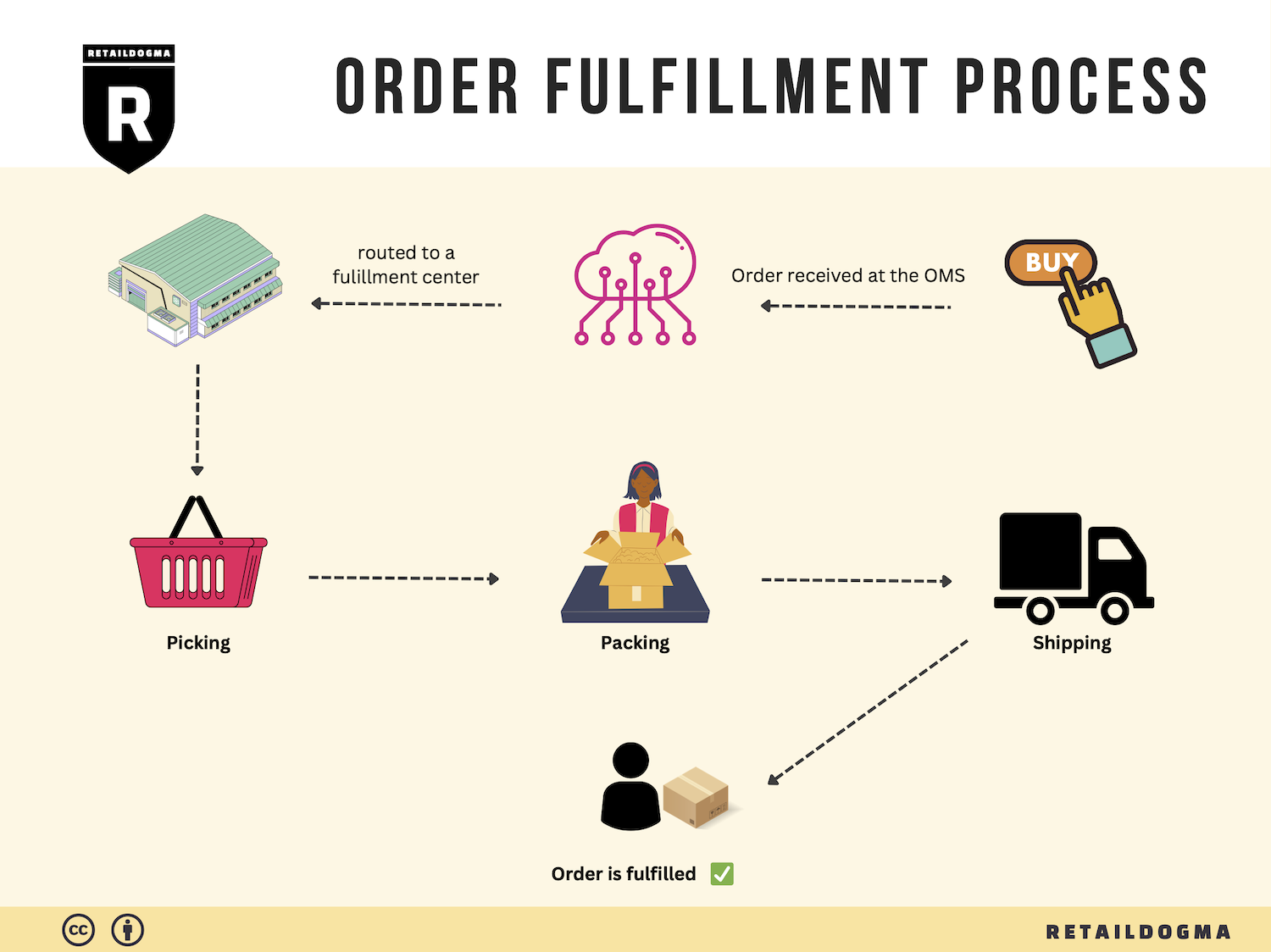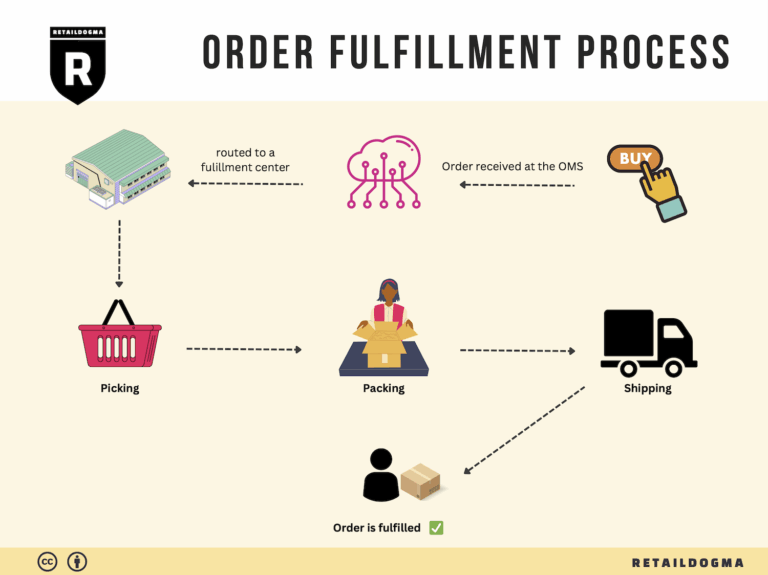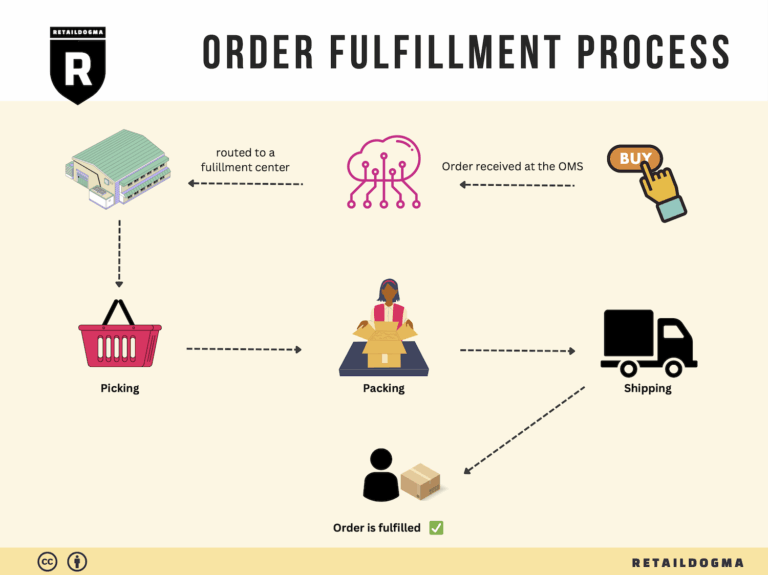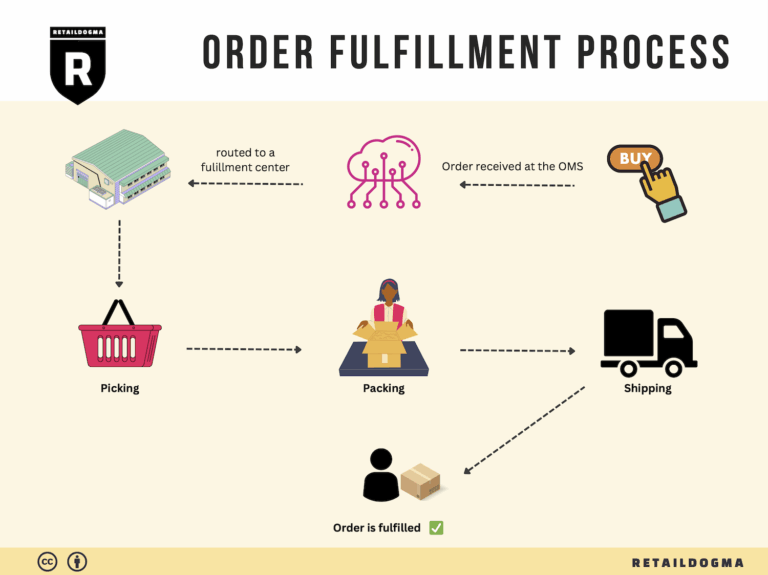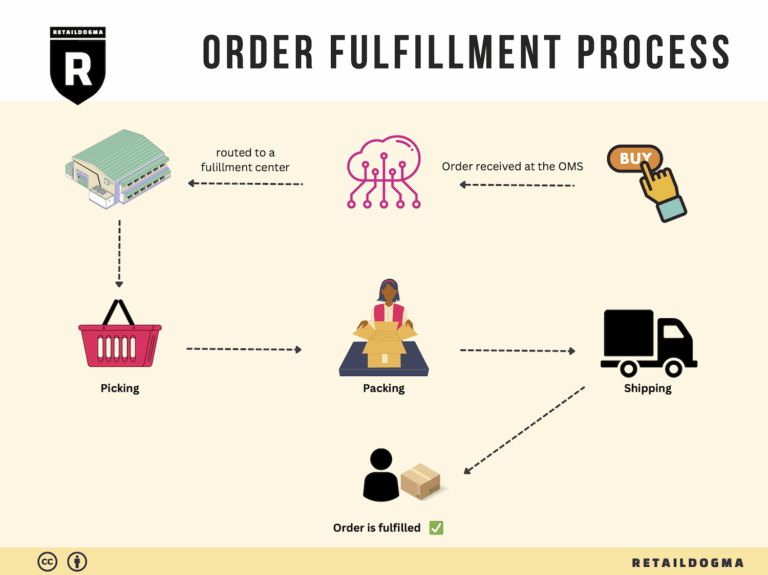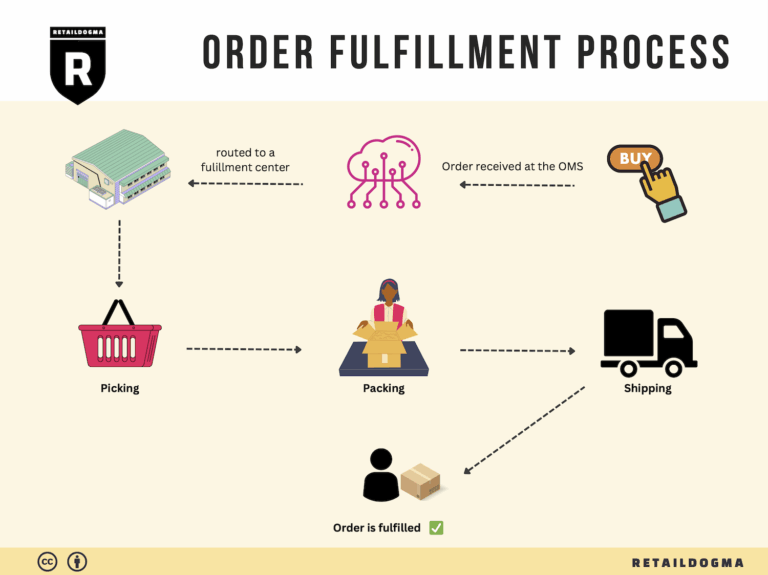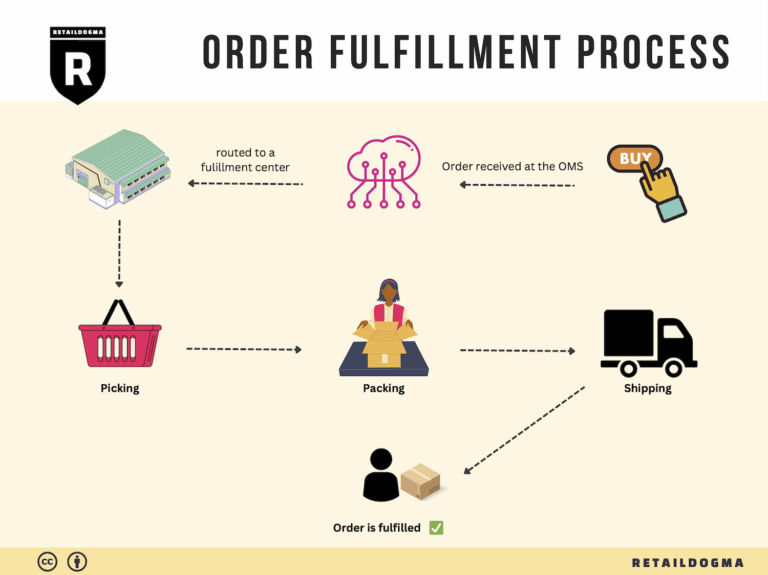What Is A Fulfillment Center? A Complete Guide (2025)
What is E-commerce Fulfillment? An Introduction for Growing Businesses
Understanding the Challenges of E-commerce Fulfillment
For many growing e-commerce businesses, the excitement of increasing sales can quickly turn into a daunting challenge when it comes to packing and shipping orders. As sales surge, so do the demands of fulfilling those orders efficiently and accurately. The process of getting a product into the hands of a customer involves various steps—inventory management, order processing, packing, and shipping—that can overwhelm even the most dedicated entrepreneurs.
What is E-commerce Fulfillment?
At its core, e-commerce fulfillment is the complete process of receiving, processing, and delivering orders to customers. This includes everything from managing your inventory and receiving orders to picking, packing, and shipping products. A seamless fulfillment process is essential for maintaining customer satisfaction and loyalty, especially in a competitive landscape where quick and reliable delivery can be a key differentiator.
What This Guide Will Cover
This guide will provide a comprehensive overview of e-commerce fulfillment, breaking down the various models available to businesses looking to scale. You’ll learn about:
-
Fulfillment Models: We will explore different fulfillment models such as Third-Party Logistics (3PL) and Fulfillment by Amazon (FBA). Understanding these options will help you determine which aligns best with your business goals and operational capabilities.
-
Core Services: We’ll highlight the essential services involved in e-commerce fulfillment, including inventory management, order processing, packing, shipping, and returns handling. Knowing what services are available can help you streamline your operations.
-
Choosing the Right Partner: Selecting the right fulfillment partner is critical for your business’s success. We will discuss key factors to consider, such as reliability, scalability, technology integration, and customer support.
-
Pricing Considerations: Finally, we will address pricing structures commonly used in the industry, helping you understand the cost implications of various fulfillment options. This knowledge will empower you to make informed decisions about your logistics budget.
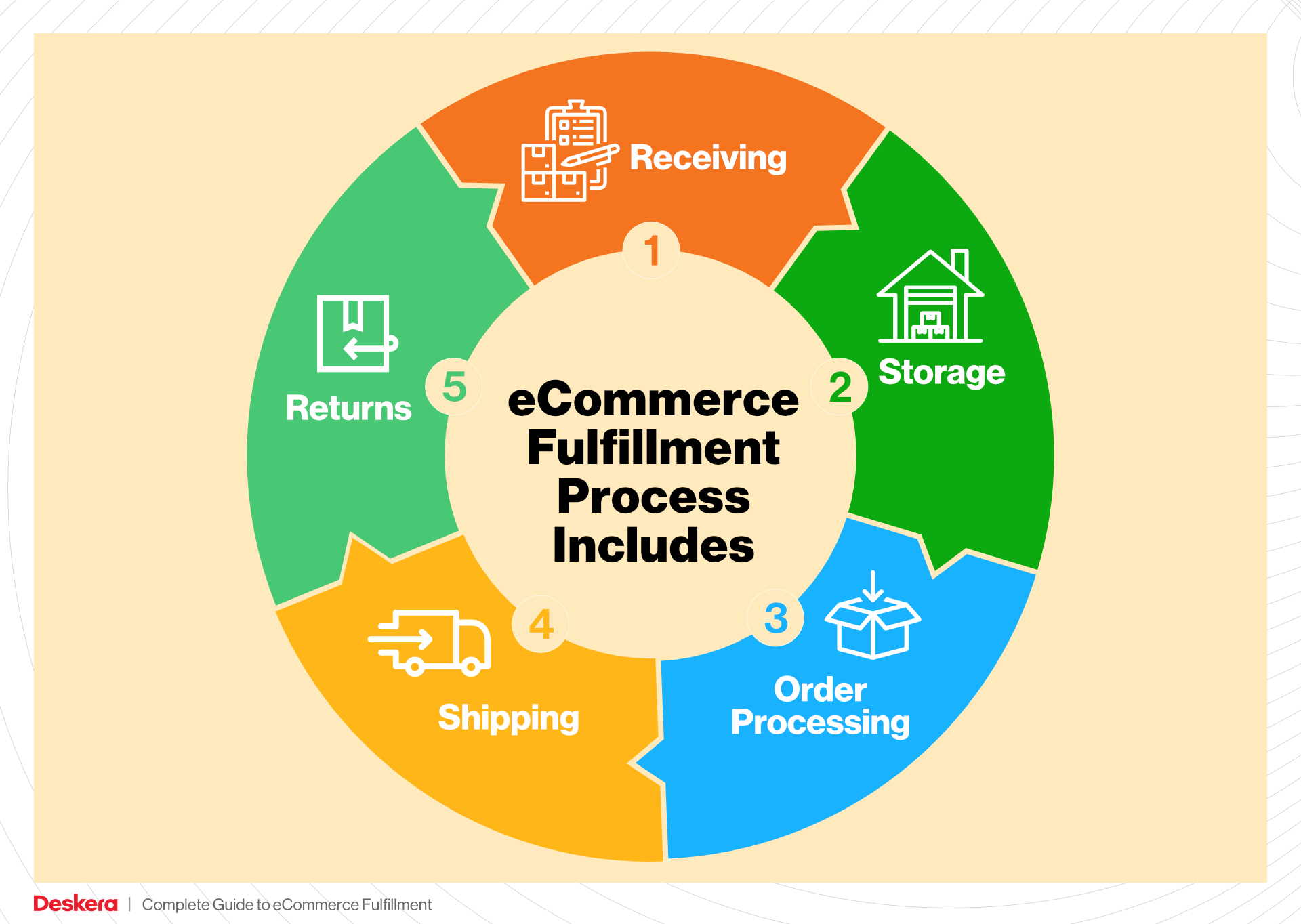
Empowering Smart Decisions in Logistics
The ultimate goal of this guide is to empower you, the business owner or operations manager, to make smart, informed decisions regarding your e-commerce fulfillment strategy. By understanding the intricacies of the fulfillment process and knowing your options, you can optimize your logistics to meet customer expectations and support your business growth effectively. Whether you’re looking to outsource fulfillment or enhance your in-house capabilities, this guide will serve as a valuable resource on your journey to scaling your e-commerce business.
What You’ll Learn In This Guide
- What is E-commerce Fulfillment? An Introduction for Growing Businesses
- The Order Fulfillment Process: From ‘Buy’ Button to Customer’s Door
- Comparing Fulfillment Models: In-House vs. 3PL vs. Dropshipping
- A Deep Dive into Amazon FBA: Pros, Cons, and Who It’s For
- Core Services Offered by Fulfillment Centers
- How to Choose a Fulfillment Partner: A 6-Point Checklist
- Understanding Fulfillment Pricing: A Breakdown of Common Fees
- Frequently Asked Questions (FAQs) about Fulfillment
- Conclusion: Is Outsourcing Fulfillment the Right Move for Your Business?
- Important Disclaimer
The Order Fulfillment Process: From ‘Buy’ Button to Customer’s Door
1. Receiving Inventory
The first step in the order fulfillment process is receiving inventory. This involves the acceptance of goods from suppliers into your fulfillment center or warehouse. Upon arrival, items are checked against purchase orders to ensure accuracy in quantity and quality. This step is critical as it sets the foundation for effective inventory management.
A key term associated with this step is SKU (Stock Keeping Unit), a unique identifier assigned to each product. Properly managing SKUs helps streamline the receiving process, as it allows for quick verification and tracking of inventory. Any discrepancies in this stage can lead to stockouts or overstocking, which can significantly impact sales and customer satisfaction. Ensuring that your receiving process is efficient and accurate can help reduce errors and improve overall supply chain efficiency.
2. Warehouse Storage
Once inventory is received and verified, the next step is warehouse storage. This involves placing products in designated locations within the warehouse for easy access and organization. Effective warehouse storage is vital for maintaining an orderly inventory system, which facilitates quicker order fulfillment.
ABC Analysis is a key term in this context. This inventory categorization technique classifies items based on their importance and sales volume. By prioritizing high-demand items for easily accessible locations, businesses can reduce picking time and enhance overall efficiency. Proper storage solutions not only optimize space but also minimize the risk of damage or loss, leading to lower operational costs and better service levels.
3. Order Picking
Order picking is the process of retrieving items from storage to fulfill customer orders. Once a customer makes a purchase, the order is sent to the warehouse team, where they use a pick list—a document that outlines the items needed for each order. This step is crucial as it directly impacts order accuracy and customer satisfaction.
There are several picking methods, including batch picking, wave picking, and zone picking, each tailored to specific business needs and order volumes. Implementing an efficient picking strategy can significantly reduce the time it takes to fulfill orders. Inaccuracies during this step can lead to customer complaints and returns, which can be costly. Therefore, investing in technology such as barcode scanners or pick-to-light systems can enhance accuracy and speed.
4. Order Packing
After items have been picked, they move to the packing stage. This involves securely packaging the products to ensure they arrive at the customer’s door in perfect condition. Proper packing is essential to protect items from damage during transit and to provide a positive unboxing experience for customers.
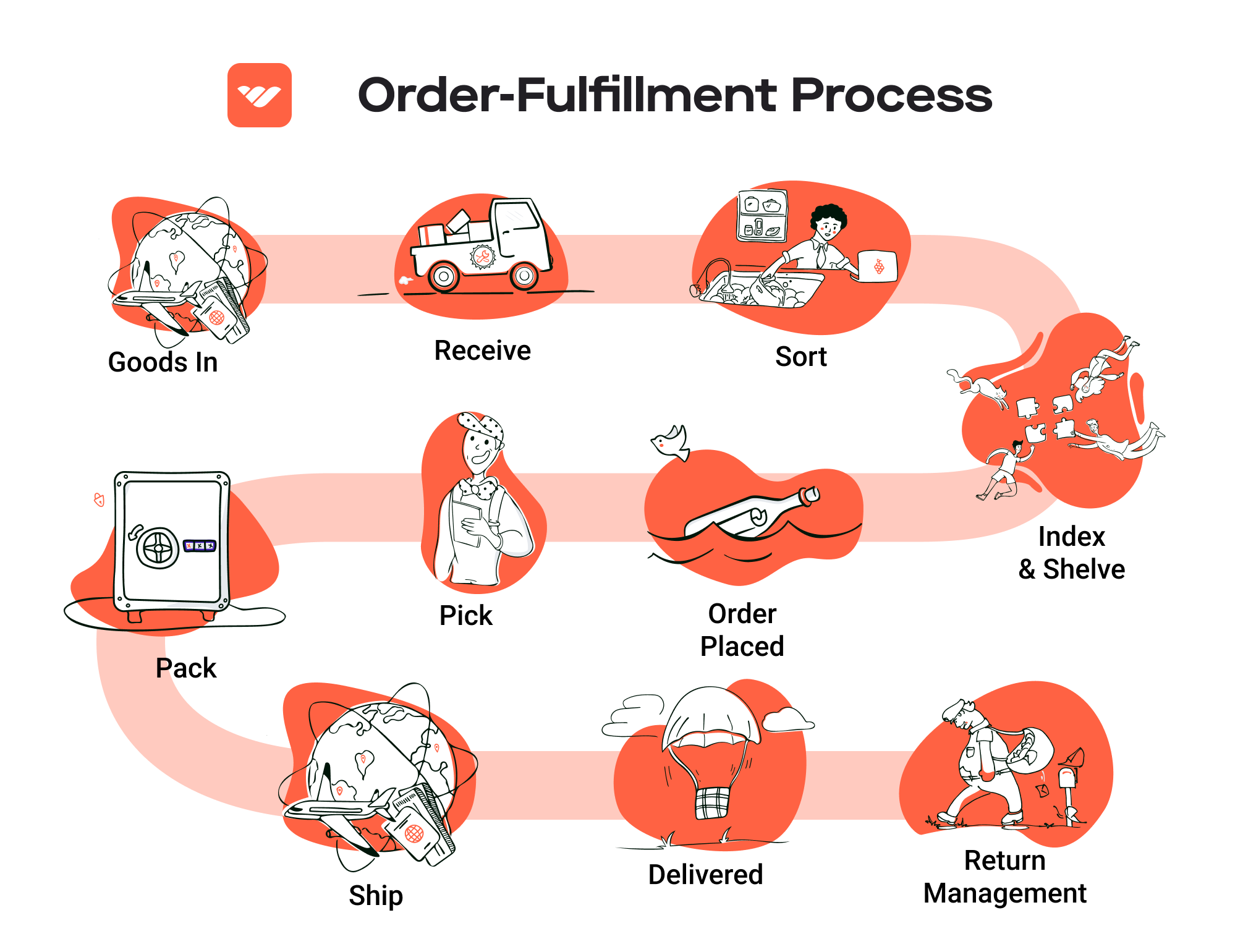
A term associated with this step is packing slips, which are documents included in the shipment that list the items in the order. This not only helps in verifying the contents but also serves as a communication tool between the business and the customer. Efficient packing processes can reduce shipping costs, enhance customer satisfaction, and minimize returns due to damages. Utilizing appropriate packing materials and methods can further streamline this process, ensuring that each package is ready for shipment quickly and effectively.
5. Shipping & Delivery
The final step in the order fulfillment process is shipping and delivery. Once orders are packed, they are labeled and sent to the designated carriers for transportation to the customer. This step is critical as it represents the last touchpoint with the customer and can significantly influence their perception of your brand.
Last-Mile Delivery is an important term here, referring to the final step of the delivery process where packages are transported from a distribution center to the customer’s doorstep. Efficient last-mile delivery is essential for timely service and customer satisfaction. Implementing tracking systems allows customers to monitor their orders in real-time, reducing anxiety and improving their overall experience.
An effective shipping strategy, including the selection of reliable carriers and optimized shipping routes, can enhance delivery speed and reduce costs. As competition in e-commerce intensifies, mastering the shipping and delivery phase is crucial for retaining customers and driving repeat sales.
In conclusion, understanding and optimizing each step of the order fulfillment process—from receiving inventory to final delivery—can greatly enhance your e-commerce operations. By implementing best practices and leveraging technology, businesses can improve efficiency, reduce costs, and ultimately elevate customer satisfaction.
Comparing Fulfillment Models: In-House vs. 3PL vs. Dropshipping
Fulfillment Models Overview
In the evolving landscape of e-commerce, businesses must carefully choose their fulfillment model to scale effectively. Each model presents unique strengths and challenges that can significantly impact operations, customer satisfaction, and overall profitability. Below, we compare three primary fulfillment models: In-House Fulfillment, Third-Party Logistics (3PL), and Dropshipping.
| Model | Who Handles Inventory | Best For (Business Stage) | Key Advantage | Key Disadvantage |
|---|---|---|---|---|
| In-House Fulfillment | The business itself | Established brands with stable demand | Greater control over inventory and customer experience | High overhead costs and resource intensity |
| Third-Party Logistics (3PL) | Third-party logistics provider | Growing businesses needing flexibility | Scalability and reduced operational burden | Less control over the fulfillment process |
| Dropshipping | Supplier/vendor | Startups and niche businesses | Low upfront investment and no inventory risk | Lower profit margins and longer shipping times |
In-House Fulfillment
In-House Fulfillment is when a business manages its own warehousing, inventory, and shipping processes. This model is often adopted by established brands with a stable demand for their products. The primary advantage of in-house fulfillment is the level of control it provides. Companies can directly manage inventory levels, shipping processes, and customer service, which can lead to enhanced customer satisfaction and loyalty. Furthermore, businesses can implement custom packaging and branding, creating a cohesive brand experience.
However, the key disadvantage lies in the high overhead costs and resource intensity associated with this model. Maintaining a warehouse, hiring staff, and investing in technology for inventory management can be capital-intensive. Additionally, as order volume fluctuates, businesses may face challenges in scaling operations efficiently without incurring additional costs. Thus, while in-house fulfillment offers control, it requires significant investment and operational capacity.
Third-Party Logistics (3PL)
Third-Party Logistics (3PL) involves outsourcing the logistics and fulfillment processes to a specialized service provider. This model is particularly beneficial for growing businesses that need flexibility and scalability. 3PL providers manage warehousing, inventory, and shipping, allowing e-commerce companies to focus on their core competencies, such as product development and marketing.
The key advantage of using a 3PL is the ability to scale operations quickly without the need for substantial upfront investment in warehousing or staff. Businesses can easily adjust their fulfillment strategies based on demand fluctuations, which is essential for seasonal businesses or those experiencing rapid growth. Moreover, 3PLs often have established shipping relationships, potentially leading to cost savings on shipping rates.
However, the downside is that businesses may experience less control over the fulfillment process. Relying on an external provider can lead to inconsistencies in service quality, especially if the 3PL does not align with the company’s standards. Furthermore, integration between the e-commerce platform and the 3PL’s systems can present challenges, particularly for businesses with unique operational requirements.
Dropshipping
Dropshipping is a fulfillment model where the retailer does not keep products in stock. Instead, when a retailer sells a product, it purchases the item from a third party (typically a wholesaler or manufacturer) who then ships it directly to the customer. This model is particularly advantageous for startups and niche businesses looking to minimize upfront investment and inventory risks.
The primary advantage of dropshipping is the low barrier to entry. Entrepreneurs can start an e-commerce business with minimal financial investment since there is no need to purchase inventory upfront. Additionally, dropshipping allows for a wide range of products to be offered without the financial commitment of holding stock, making it an attractive option for businesses testing new markets or product lines.
However, dropshipping also presents challenges, notably lower profit margins. Retailers often have to compete on price, which can squeeze profits. Additionally, shipping times may be longer, especially if suppliers are located overseas, leading to potential customer dissatisfaction. Furthermore, the retailer has little control over inventory levels, which can result in stockouts or delays in fulfillment. As a result, while dropshipping offers flexibility and lower risk, it requires careful management of supplier relationships and customer expectations.
Conclusion
Choosing the right fulfillment model is critical for e-commerce businesses aiming to scale effectively. Each model—In-House Fulfillment, Third-Party Logistics, and Dropshipping—offers distinct advantages and disadvantages that can impact operational efficiency, customer satisfaction, and profitability. Businesses must evaluate their current stage, financial resources, and long-term goals to select the model that best aligns with their strategic vision. By understanding the nuances of each fulfillment option, e-commerce owners can make informed decisions that drive growth and enhance the overall customer experience.
A Deep Dive into Amazon FBA: Pros, Cons, and Who It’s For
Understanding Fulfillment by Amazon (FBA)
Fulfillment by Amazon (FBA) is a service provided by Amazon that allows sellers to store their products in Amazon’s fulfillment centers. Amazon then takes care of storage, packaging, and shipping of products directly to customers. This service is designed to simplify the logistics of e-commerce for sellers, enabling them to focus on growing their business while leveraging Amazon’s vast resources and customer base.
How FBA Works
-
Account Setup: To use FBA, sellers must first create an Amazon Seller Account. During the setup process, sellers can choose to enroll in FBA.
-
Inventory Preparation: Sellers prepare their products according to Amazon’s guidelines, which include packaging and labeling requirements. It’s crucial to adhere to these standards to avoid delays and additional fees.
-
Shipping to Amazon: Once the products are ready, sellers ship them to Amazon’s designated fulfillment centers. Amazon has numerous fulfillment centers across various locations, which helps to reduce shipping times.
-
Order Processing: When a customer places an order, Amazon takes care of the entire fulfillment process. This includes picking the product from the shelf, packing it, and shipping it directly to the customer.
-
Customer Service and Returns: Amazon also manages customer service and returns for FBA orders. This means that sellers do not need to handle customer inquiries or returns directly.
-
Payment: After the sale, Amazon deducts its fees from the sale price, and the remaining balance is transferred to the seller.
Pros of Using FBA
-
Prime Eligibility: One of the most significant advantages of FBA is that it makes products eligible for Amazon Prime. This can greatly enhance visibility and attractiveness to customers who prefer quick, free shipping.
-
Customer Trust: Products fulfilled by Amazon benefit from the trust associated with the Amazon brand. Customers are often more inclined to purchase items that are backed by Amazon’s fulfillment services due to perceived reliability and quality.
-
Multi-Channel Fulfillment: FBA allows sellers to fulfill orders not just from Amazon but also from other sales channels. This means that businesses can sell on their own websites or other marketplaces while still utilizing Amazon’s logistics capabilities.
-
Scalability: FBA provides a scalable solution for growing businesses. As sales increase, sellers can send larger quantities of inventory to Amazon without needing to invest in their own warehousing and logistics infrastructure.
-
Time-Saving: By outsourcing logistics to Amazon, sellers can focus on other essential aspects of their business, such as marketing, product development, and customer engagement.
Cons of Using FBA
-
High Fees: While FBA offers many benefits, it also comes with various fees, including storage fees, fulfillment fees, and additional costs for long-term storage. These fees can accumulate quickly and eat into profit margins.
-
Strict Inventory Rules: Amazon has strict guidelines regarding inventory management. Sellers must adhere to these rules to avoid penalties, which can be challenging for businesses with fluctuating inventory levels.
-
Commingling Risks: When using FBA, products from different sellers can be commingled in Amazon’s warehouses. This poses a risk if a customer receives a defective or damaged item that is not yours, potentially leading to negative feedback or returns that could affect your seller rating.
-
Less Control Over Fulfillment: By relying on Amazon for fulfillment, sellers lose some control over how their products are handled, packaged, and shipped. This can be particularly concerning for brands that prioritize specific packaging or customer experience.
-
Inventory Limitations: Amazon places limits on the amount of inventory that can be stored in its warehouses, especially for new sellers. This can restrict growth potential if not managed carefully.
Who is FBA Best For?
Fulfillment by Amazon is best suited for:
-
Small to Medium-Sized Businesses: Companies looking to scale quickly without investing heavily in logistics infrastructure can benefit significantly from FBA.
-
E-commerce Entrepreneurs: Those who are new to e-commerce and want a streamlined process for order fulfillment can leverage Amazon’s established logistics network.
-
Brands Seeking Visibility: Businesses that aim to increase their market presence and gain access to Amazon’s vast customer base can take advantage of FBA’s Prime eligibility and customer trust.
-
Multi-Channel Sellers: Brands that sell on multiple platforms and want to simplify their fulfillment process will find FBA advantageous, allowing them to use Amazon’s services for various sales channels.
-
Seasonal Businesses: Companies with seasonal spikes in sales can utilize FBA to handle increased order volumes without the need for permanent warehousing solutions.
In conclusion, while Fulfillment by Amazon offers numerous benefits that can significantly enhance an e-commerce business, it is essential for sellers to carefully weigh the pros and cons. By understanding the implications of using FBA, businesses can make informed decisions that align with their operational goals and customer expectations.
Core Services Offered by Fulfillment Centers
Inventory Management & Warehousing
Inventory management and warehousing are foundational services provided by fulfillment centers. This involves the systematic storage of products in a dedicated facility, where inventory is organized, tracked, and managed efficiently. Fulfillment centers utilize advanced inventory management systems that provide real-time visibility into stock levels, allowing businesses to monitor their inventory accurately.
Benefits: For e-commerce businesses, effective inventory management minimizes the risks of overstocking or stockouts, both of which can significantly impact cash flow and customer satisfaction. By outsourcing warehousing to a fulfillment center, businesses can reduce overhead costs associated with maintaining their own storage facilities, including rent, utilities, and staffing. Furthermore, fulfillment centers often have the capacity to scale inventory levels in response to demand fluctuations, ensuring that businesses can meet customer expectations without incurring unnecessary costs.
Pick and Pack Services
Pick and pack services are integral to the order fulfillment process. This service involves selecting (picking) the ordered items from inventory and then packing them securely for shipment. Fulfillment centers employ trained staff and automated systems to ensure accuracy and efficiency in picking orders. The packing process often includes the use of branded packaging materials to enhance the customer experience.
Benefits: This service streamlines the order fulfillment process, significantly reducing the time from order placement to shipment. For e-commerce businesses, this means faster delivery times, which can lead to higher customer satisfaction and repeat business. Additionally, fulfillment centers can optimize the packing process to minimize shipping costs, often leading to lower overall expenses for the business. The accuracy of pick and pack services also reduces the likelihood of returns due to shipping errors, further enhancing profitability.
Kitting and Assembly
Kitting and assembly refer to the process of combining multiple products into a single package or kit, which is then shipped to customers. This service is especially useful for businesses that sell bundled products or promotional items. Fulfillment centers can handle the assembly of these kits, ensuring that they are packaged correctly and meet quality standards before shipping.
Benefits: For e-commerce businesses, kitting and assembly can create unique selling propositions by offering customers curated products that enhance their shopping experience. This service can also simplify inventory management by reducing the number of SKUs (stock-keeping units) that need to be tracked. By outsourcing kitting and assembly, businesses can focus on their core operations, such as marketing and product development, while leaving the logistical complexities to the fulfillment center.
Returns Management (Reverse Logistics)
Returns management, often referred to as reverse logistics, is a critical service offered by fulfillment centers that involves processing returned items. This includes receiving returned products, inspecting them for quality, restocking items when possible, and managing the logistics of returning items to suppliers or disposing of them if necessary.
Benefits: An efficient returns management system is vital for maintaining customer satisfaction and loyalty in e-commerce. Many customers consider the ease of returns when making a purchase decision. Fulfillment centers streamline this process by providing clear instructions for returns, handling logistics, and updating inventory records swiftly. By ensuring that returns are managed effectively, businesses can minimize losses associated with returned merchandise and maintain a positive brand reputation. Moreover, a seamless return process can lead to increased customer trust, encouraging repeat purchases.
Conclusion
The core services offered by fulfillment centers—inventory management and warehousing, pick and pack services, kitting and assembly, and returns management—are essential for e-commerce businesses aiming to scale operations efficiently. By leveraging these services, businesses can enhance their operational efficiency, reduce costs, and improve customer satisfaction, ultimately leading to increased sales and growth in a competitive market. Partnering with a fulfillment center allows e-commerce businesses to focus on their core competencies while ensuring that logistics and order fulfillment are handled by experts in the field.
How to Choose a Fulfillment Partner: A 6-Point Checklist
Location & Warehouse Network
Importance:
The geographical location of your fulfillment partner’s warehouses can significantly impact your shipping times and costs. A partner with a strategically placed network of warehouses enables faster delivery to your customers, which can enhance customer satisfaction and reduce shipping expenses.
Questions to Ask:
– Where are your warehouses located, and how many do you operate?
– How do you determine the best warehouse to ship from for my orders?
– Can you provide shipping estimates based on my target markets?
– Do you have plans for expanding your warehouse network in the near future?
Technology & Integrations
Importance:
In today’s digital landscape, robust technology and seamless integrations with your existing e-commerce platforms are essential for operational efficiency. A fulfillment partner should provide real-time inventory tracking, order management, and reporting capabilities to ensure smooth operations.
Questions to Ask:
– What technology do you use for order processing and inventory management?
– Can your system integrate with my current e-commerce platform (e.g., Shopify, WooCommerce)?
– How do you handle inventory updates, and how often is this information synchronized?
– Do you offer a customer portal for tracking orders and inventory?
Specializations (e.g., Cold Storage, Oversized Items)
Importance:
Certain businesses may require specialized fulfillment services, such as temperature-controlled storage or handling oversized items. Choosing a partner with the right expertise can prevent logistical challenges and ensure compliance with industry standards.
Questions to Ask:
– Do you have specialized facilities for specific types of products (e.g., cold storage, fragile items)?
– How do you ensure compliance with regulations for specialized items?
– What experience do you have in handling products similar to mine?
– Can you accommodate seasonal fluctuations in inventory or demand?
Scalability & Capacity
Importance:
As your business grows, your fulfillment needs will evolve. A capable partner should be able to scale operations to accommodate increased order volumes without compromising service quality. Understanding their capacity can help you avoid potential fulfillment bottlenecks.
Questions to Ask:
– What is your current capacity for order fulfillment, and how do you handle peak seasons?
– How quickly can you scale operations if my sales increase significantly?
– Do you have contingency plans in place for unexpected spikes in demand?
– Can you provide historical data on how you’ve managed capacity changes for other clients?
Pricing and Contracts
Importance:
Pricing structures can vary widely among fulfillment partners. It’s crucial to understand the costs involved and how they align with your budget and profit margins. Transparent pricing will help you avoid hidden fees that could impact your bottom line.
Questions to Ask:
– What is your pricing structure (e.g., per order, per item, monthly fees)?
– Are there any additional fees for services such as storage, returns, or kitting?
– Can you provide a breakdown of all potential costs in a clear format?
– What are the terms of your contract, and is there flexibility for renegotiation as my business evolves?
Customer Support & Reviews
Importance:
Exceptional customer support is vital for maintaining a smooth operation and addressing issues promptly. Investigating reviews and testimonials can provide insight into the partner’s reliability and service quality.
Questions to Ask:
– What level of customer support do you provide (e.g., dedicated account manager, 24/7 support)?
– How do you handle customer complaints and issues?
– Can you share references or case studies from clients in my industry?
– What is your average response time for support inquiries?
Conclusion
Choosing the right fulfillment partner is a critical decision that can significantly influence your e-commerce operations and customer satisfaction. By evaluating potential partners against this checklist, you can ensure that you make an informed choice that aligns with your business goals and growth strategy. Prioritize open communication and transparency throughout the selection process, as these qualities are indicative of a strong partnership.
Understanding Fulfillment Pricing: A Breakdown of Common Fees
Initial Setup Fees
When partnering with a fulfillment center, businesses often encounter initial setup fees. These are one-time charges associated with establishing your account and preparing your inventory for storage and distribution. The costs can vary based on the complexity of your operations and the specific services required. For example, if you need assistance with integrating your e-commerce platform or custom software development, additional fees may apply.
Typically, initial setup fees can range from a few hundred to several thousand dollars, depending on factors such as:
- Inventory Assessment: A thorough evaluation of your inventory and its specific storage needs.
- Technology Integration: Costs associated with connecting your e-commerce platform with the fulfillment center’s systems.
- Training and Onboarding: Fees for training staff on the fulfillment processes and systems.
Receiving Fees
Receiving fees are charged when your inventory arrives at the fulfillment center. This fee covers the labor and resources required to unload, inspect, and store your products. It is usually calculated per pallet or per item, depending on the fulfillment center’s policies.
Factors that influence receiving fees include:
- Volume of Inventory: Higher volumes may lead to lower per-unit costs due to economies of scale.
- Condition of Goods: If items require special handling or inspection, additional charges may be incurred.
- Complexity of Inventory: Unique or oversized items might attract higher fees due to specialized handling requirements.
Storage Fees (per pallet/bin)
Storage fees are charged for the space your inventory occupies within the fulfillment center. These fees can be billed monthly and are typically calculated on a per-pallet or per-bin basis. This means you’ll pay for the space your products occupy, regardless of whether they are actively being picked and shipped.
Key considerations for storage fees include:
- Duration of Storage: Longer storage periods can lead to higher cumulative costs. Some fulfillment centers may offer tiered pricing for longer commitments.
- Type of Storage: Specialized storage conditions (e.g., climate control) might incur additional costs.
- Inventory Turnover Rate: Slow-moving inventory may attract additional fees, such as long-term storage fees, to incentivize faster turnover.
Pick & Pack Fees (per item/order)
Pick and pack fees are incurred each time an order is processed. This fee covers the costs associated with selecting the items from storage (picking) and packaging them for shipment (packing). Pick and pack fees are generally calculated per item or per order, depending on the fulfillment center’s pricing structure.
Factors influencing pick and pack fees include:
- Order Complexity: Orders with multiple items may be charged at a higher rate than single-item orders due to increased handling time.
- Packaging Requirements: If you require custom packaging or additional materials, expect to pay higher fees.
- Frequency of Orders: Regular customers may negotiate lower rates based on their order frequency and volume.
Shipping Fees
Shipping fees cover the costs of transporting your products from the fulfillment center to your customers. These fees can vary significantly based on several factors, including shipping method, destination, weight, and dimensions of the package.
Consider the following when evaluating shipping fees:
- Carrier Choices: Different carriers (e.g., UPS, FedEx, USPS) offer varying rates and delivery times, allowing you to choose based on your budget and service level.
- Shipping Zones: Costs typically increase with distance; thus, shipping to faraway locations will incur higher fees.
- Volume Discounts: Many fulfillment centers offer discounted shipping rates for larger volumes, so it’s worth inquiring about potential savings.
Tips for Getting an Accurate Quote
- Provide Comprehensive Information: When requesting a quote, include details about your product dimensions, weights, and any special handling requirements.
- Inquire About All Fees: Ensure you understand all potential fees, including those for receiving, storage, and shipping, to avoid surprises later.
- Compare Multiple Providers: Don’t settle for the first quote; compare offerings from different fulfillment centers to find the best fit for your needs.
- Ask for a Breakdown: Request a detailed breakdown of the quote to see how each fee contributes to the overall cost, enabling better budget planning.
- Negotiate Terms: Many fulfillment centers are open to negotiation, especially for larger volumes or long-term contracts, so don’t hesitate to discuss pricing options.
By understanding these common fulfillment pricing models and employing strategic approaches to obtain quotes, e-commerce business owners can make informed decisions that will ultimately enhance their operational efficiency and profitability.
Frequently Asked Questions (FAQs) about Fulfillment
1. What is a Target Fulfillment Center?
A Target Fulfillment Center is a specialized facility designed to manage the storage, picking, packing, and shipping of products for online orders. These centers leverage Target’s extensive retail network to efficiently fulfill e-commerce transactions, enabling faster delivery times to customers.
2. How does Target’s fulfillment strategy work?
Target utilizes a hybrid model that combines traditional warehouses with in-store fulfillment capabilities. Approximately 25% of Target’s stores are equipped to handle online order fulfillment, allowing them to act as mini-distribution centers. This strategy enables quicker shipping times and improved inventory management.
3. What’s the difference between a warehouse and a fulfillment center?
While both warehouses and fulfillment centers store inventory, their functions differ significantly. A warehouse primarily focuses on long-term storage of goods, whereas a fulfillment center is optimized for order processing, including picking, packing, and shipping directly to customers. Fulfillment centers also often provide additional services like returns management and inventory tracking.
4. What is a 3PL?
A Third-Party Logistics provider (3PL) is a company that offers outsourced logistics services, including warehousing, fulfillment, and distribution. Businesses often partner with 3PLs to manage their supply chain operations more efficiently, allowing them to focus on core business activities while leveraging the expertise of logistics specialists.
5. How much do fulfillment services cost?
The cost of fulfillment services can vary widely based on factors such as order volume, storage space, and the complexity of services required. Generally, businesses can expect to pay for storage fees (typically calculated per pallet or cubic foot), picking and packing fees (charged per order), and shipping costs. It’s crucial for businesses to obtain detailed quotes from fulfillment providers to understand their pricing structures.
6. What are the benefits of using a Target Fulfillment Center?
Using a Target Fulfillment Center offers several benefits, including faster shipping times, improved inventory management, and access to Target’s extensive network of retail locations. This model allows businesses to capitalize on Target’s logistics infrastructure, which can enhance customer satisfaction through quicker delivery and streamlined order processing.
7. Can I integrate my e-commerce platform with Target’s fulfillment services?
Yes, many fulfillment providers, including Target, offer integration capabilities with popular e-commerce platforms. This allows for seamless order processing and inventory management, ensuring that your online store is always up-to-date with stock levels and order statuses.
8. What types of products can be fulfilled through a Target Fulfillment Center?
Target Fulfillment Centers can handle a wide variety of products, from electronics to apparel and home goods. However, specific restrictions may apply based on the nature of the products and their storage requirements. It’s advisable to check with Target for detailed product eligibility.
9. How does Target handle returns and exchanges?
Target has established procedures for managing returns and exchanges, ensuring a smooth process for customers. Typically, returned items are shipped back to the fulfillment center, where they are inspected and restocked if they meet quality standards. Businesses utilizing Target’s fulfillment services can leverage these processes to enhance customer satisfaction.
10. What measures does Target take to ensure inventory accuracy?
Target employs advanced inventory management systems, including technologies like RFID tagging, to track stock levels accurately. Regular audits and real-time data updates help maintain inventory integrity, ensuring that businesses can fulfill orders without discrepancies between available stock and customer demand.
Conclusion: Is Outsourcing Fulfillment the Right Move for Your Business?
Evaluating the Advantages of Outsourcing Fulfillment
Outsourcing fulfillment can be a transformative strategy for e-commerce businesses looking to enhance efficiency and scalability. By partnering with a fulfillment service, you can save significant time and resources. These services manage inventory, picking, packing, and shipping, allowing you to concentrate on core business activities such as marketing, product development, and customer engagement. This delegation not only streamlines operations but also frees up your team to focus on growth initiatives.
Moreover, leveraging the expertise of a fulfillment partner can provide insights and best practices that may not be readily available in-house. Fulfillment centers often have access to advanced technologies and logistics networks that can improve order accuracy and delivery speed. For example, services that offer same-day shipping or international shipping solutions can elevate your customer experience, making your brand more competitive in a crowded market.
Scalability is another compelling benefit of outsourcing. As your business grows, fulfillment needs can fluctuate significantly. A capable partner can easily adjust to your changing demands, whether you’re experiencing peak seasons or expanding product lines. This flexibility ensures that you can meet customer expectations without the burden of managing increased operational complexities.
However, the success of outsourcing fulfillment hinges on selecting the right partner. Conduct thorough research to assess potential providers based on their capabilities, technology, and customer service. A misaligned partnership can lead to operational disruptions and negatively impact your brand reputation.
Strategic Call-to-Action
As you contemplate the future of your logistics strategy, consider conducting an audit of your current shipping processes. Evaluate whether your existing setup is meeting your growth objectives and customer expectations. If you identify inefficiencies or limitations, it may be time to explore fulfillment partnerships that can propel your business forward. Don’t hesitate to reach out to potential partners to discuss how they can align with your business goals and enhance your fulfillment strategy.
Important Disclaimer
⚠️ Important Disclaimer
The information in this guide is for educational purposes. Fulfillment services, pricing, and platform features change frequently. Always conduct your own due diligence and consult with providers directly before making business decisions.
